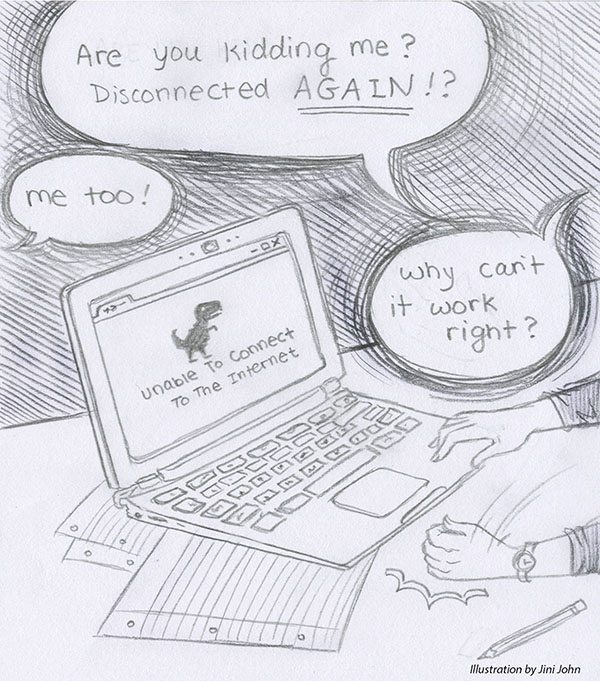District 225 plans to upgrade technology
November 6, 2015
The Northfield Township Technology Consortium (NTTC) will be implementing a technological upgrade to GBS and other schools in December 2015 or March 2016.
According to the official website of the NTTC, the organization was created to share Internet and other technological resources across school districts, municipalities and others. R.J. Gravel, director of technology services for District 225, detailed the reason behind the upgrade at GBS.
“What we’ve done is come together and say, ‘Why do we have a connection to Comcast, a connection to Hurricane Electric (which gives us internet), [or] a connection to AT&T?’” Gravel explained. “‘Let’s all come together and get a really big connection, share it, and then decrease our costs.’”
Gravel says the different buildings and a few elementary schools that share the bandwidth connections with South use a layer-three and layer-two networking environment.
“We take all of these separate locations, bring them together through fiber wires running between our buildings and our neighboring school districts and enable them to all connect to the same Internet connection,” Gravel said.
He also states that each building used to have two physical pieces of equipment that allowed for the network to connect between buildings, and the upgrade was made to reduce it to one piece of equipment.
“Instead of looking at it all separately, we’re [going to] run one network,” Gravel said. “We’re going to have this multi-lane highway, and we are going to translate how we route things to the Internet or to each other in terms of the computer a little differently, and that’s what this new hardware will allow us to do.”
According to Gravel, the decision for the upgrade was made prior to his employment by Ryan Bretag, former director of educational technology and interim director of technology services, and Marcus Thimm, former technical services director.
“[Bretag and Thimm] put together a plan, presented it to the Board of Education; the Board approved the amount of money to be spent [and] approved the scope of the project,” Gravel said. “Upon my arrival in July, the equipment had already been purchased, and now it was [to] plan and [scope] it out.”
The upgrade was supposed to be implemented on Oct. 9, but because of minor issues, the process was delayed until Sunday, Oct. 11. Gravel says the department then decided to revert back to the old system until the upgrade can be made securely.
“We had everyone talking and working with each other, but one of the difficult things you run into when you’re working with an upgrade is [that] you need to do a substantial amount of testing,” Gravel said. “So, you [have to] change how the buildings communicate with each other, [and how] they get to the Internet. You want to make sure you go into [any] classroom and [see everything] wirelessly connected to our hardware network. We want to make sure things are working.”
According to Gravel, the upgrade was chosen, not because there were faults with the network designed, but to make the network better in terms of streamlining, troubleshooting and pieces of equipment that can fail or break.
“When a classroom reports that there is an issue, [that] not all the students can get to Google Drive [or that] not everyone can do x, y and z, [the update will] let us decrease some of the points that we have to look at, so we [can] respond to those issues quicker and more efficiently,” Gravel said.
Sophomore Hao Chen says there have been multiple instances when the school network was not working well.
“[The Internet] takes forever to load, and it usually encounters a problem, so you have to restart the computer,” Chen said.
David Rogers, Computer Science teacher, reveals that there were several times during class when the server was not working, preventing students from doing what they were supposed to.
“We’re limited in what we can do,” Rogers said. “It’s possible that students don’t have to use the network for what they’re doing, but if they’ve started a file, and it lives on the network, then they can’t get to it. So they [will] have to start something totally new.”
Rogers said that if the Computer Science classes switch to laptops and begin to run wirelessly, the upgrade will be beneficial.
“Even now, with the wired [computers], we’re still connected to a file server, and many times that slows down to a crawl,” Rogers said. “So it’s still up and available, but it’s so slow that it can’t operate, because it just takes too long. So things that would take less than one second now take several minutes.”
Rogers said that he is open to the technology upgrade if they fix the problems that the Computer Science classes are currently facing.
“I look forward to [the upgrade], because there have been several times that, all of a sudden, everybody’s machines slows down to a point that it’s almost unusable,” Rogers said. “That can be really frustrating.But, if it’s part of the upgrade, I welcome that.”
According to Gravel, the issue the Computer Science classes are experiencing is called a wireless Internet connectivity issue. Although this issue will not be the focus of the upcoming upgrade, Gravel says that there are other plans for similar problems that are happening at GBS.
“While this network enhancement will help provide a more stable network infrastructure across buildings and our elementary feeder districts, this particular enhancement is not targeted at improving these types of issues,” Gravel said. “We do have other initiatives that we are working on to provider greater stability in our wireless network and increased coverage.”



